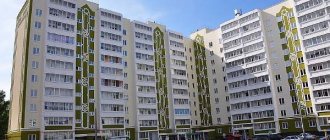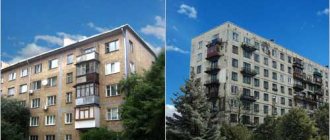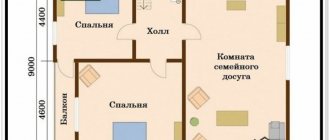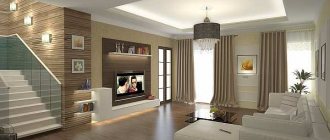How many meters in a nine-story building?
Arithmetic mean and standard height The conditionally average height of a nine-story building in meters is usually determined in the range of 27–30 m.
Interesting materials:
What applications can be used for Samsung Smart TV? What applications can be installed on Huawei? What examples of graphic editors for vector images can you give? What seasonings can be used for vegetables? What signs can be seen when holding a bill through the light? What foods can cause acne? What plants can be grown in pots outside? What plants can be grown in a greenhouse? What vegetable oils can be mixed? What fish can live with shrimp?
Classification of heights and types of buildings with different number of storeys
To calculate the total height of a house, building, structure, the distance from the floor to the ceiling of each floor and the thickness of each interfloor ceiling are taken into account. If the attic space is higher than 1.8 m and wider than 1.6 m, and the basement floor rises more than 2 m above the ground, then they will also be counted as separate floors. This is stated in the explanations of Rosreestr - for example, letter from the FSGR, cadastre and cartography No. 4200-AB/20 dated May 12, 2020 (“On the number of floors of individual housing construction projects”).
A brief general classifier of the number of storeys and heights of buildings:
- Low-rise. The number of floors is from 1 to 3. The maximum height of the house is up to 12 m.
- Mid-rise. Floors – from 3 to 5. Building height – up to 15 m (5-storey standard).
- Increased number of storeys. From 6 to 10 floors. The highest height is 30 m.
- Multi-storey. Number of floors – 10-25. Allowable heights are grouped by building categories.
- High-rise. Floors - from 25 to 30. Height starts from 100 m or more.
Types of foundation
According to the method of execution, it is divided into several types. The most common ones are:
- columnar;
- pile;
- tape;
- monolithic slab.
Private residential building
Columnar
The use of the presented type is more justified in the construction of panel townhouses, and, for example, houses made of aerated concrete or a Finnish mansion made of timber boards resting on pillars have gained popularity not only in our country, but also abroad.
The technology for constructing such a foundation boils down to installing supports along the intended perimeter of the future building. They are installed at certain intervals in pre-drilled holes. The diameter of the latter is variable.
Taking into account what depth is most appropriate in a particular case, builders give preference to different types of pillars. Pipes, reinforced concrete stepsons, logs, and natural stone can act as supports.
Stobs
Pile
Another type of supporting element that has become widespread in various fields of construction is the pile. Modern technology for using piles as a key component of the supporting surface is a single complex of complementary structural elements.
This engineering solution eliminates deformation of individual peripheral parts and ensures uniform distribution of force on the ground.
According to the principle of pile installation, the pile foundation is divided into hanging and retaining.
Scheme of the pile-tape design option
The first category of load-bearing supports is installed in dense soil layers, the height of which reaches several meters. Piles are driven into the ground at calculated intervals. A significant part of the load of such a support falls on its side surface, while the base plays a secondary role.
In this position, the soil under the pressure of the support walls can, as they say, “crawl.” This disadvantage is compensated for in the following ways:
- increasing the cross-section of workpieces;
- increasing the length of the pile;
- giving the shape of the pile convexities at the base and in places of lateral contact with the ground;
- increasing the density of pile installation.
Screw pile installation diagram
Retaining piles are very different in functionality from previous models. Unlike pile and hanging supports, this type of base structure is driven to a shallow depth with a small interval between two adjacent elements. The average height of such supports is 40–70 cm. This technology is typical for 1-story frame-type buildings.
Tape
The so-called strip type of laying the foundation of a building deserves special attention. Its fundamental difference is that in the presented case they use a block type of backfill or a continuous concrete strip.
In accordance with the requirements for strength and load, the blocks can have a solid or hollow structure. Houses made of aerated concrete based on this technology are characterized by high seismic resistance and durability.
Depth drawing
Monolithic slab
Slab foundation - it is characterized by a large load-bearing area and an exceptionally high level of resistance to seismic ground vibrations.
In the event of natural disasters that cause displacement or subsidence of the soil, such a structure will remain intact and unharmed due to the large base area of the monolithic foundation, made in the form of a single slab.
The height of such a platform varies according to the conditions of a particular area. However, the implementation of such a project will require significant material investments. On average, it takes about 20–25 m3 of concrete to make a slab alone, but it all depends on the size and loads of the building.
Reinforcement of a monolithic slab
This is interesting: Monolith electrodes - technical characteristics, reviews
How to check the soil under the foundation yourself
Checking the soil by color
Drilling test wells. By drilling a small shaft 1-2 meters deep, you can visually determine some of the qualities of the soil. You can also dig a small pit, thereby determining the location of the load-bearing layer of soil, loam or clay. But this is all relative; if analysis is impossible, a reinforced foundation is laid on piles or concrete pillars.
Direct factors, such as the presence of water, sand particles and stones, will prompt the choice and direction. But they do not cancel the need to do an analysis.
Of course, in most cases of construction of country houses, few people conduct such an analysis. Then it is recommended to develop the trench to a dense load-bearing layer. Here we will analyze more precisely all the stages, both for a one-story house and for a two-story one.
Accepted Standards
Height of a 5 storey building
It is necessary to take into account, first of all, some existing regulations and standards. In addition to purely practical standards, depending on the complexity of the work and cost, there is a legally formalized set of SNiP (building codes and regulations). This document establishes the minimum permissible height of a residential premises, based on fire safety and the safety of the structure of the structure.
According to him:
- the height of rooms and kitchen areas should not be lower than 2.5 m;
- height of corridors and halls – 2.1 m;
- the height of the attic depends on the angle of inclination and is 1.3 m at an angle of 30° and is not standardized at an angle of 45° or more.
The minimum height normalized by the rules is not always optimal. Builders have their own standards, supported by experience and knowledge of the matter. Of course, everything depends on each specific case.
For example, for a luxurious stone mansion you should not make ceilings of the same height as for a modest wooden house in the village, but, based on the average size of a brick or wooden cottage, the standard height is 2.7-2.9 m.
This number allows you to find a balance between oppressive low ceilings and expensive high ones. Most country houses are built following this standard. And for good reason: standard height has huge advantages that many do not notice.
Numbering of floors in different countries [ edit | edit code]
| Number of levels above ground level | Europe, Australia and Asia | USA, Canada, Norway | Former USSR, some Asian countries | Japan and Korea | India |
| 4 levels above the main floor | 4 (“4th floor”) | 5 ("5th floor") | 5 ("5th floor") | 5F or 6F | 4 (“4th floor”) |
| 3 levels above the main floor | 3 (“3rd floor”) | 4 (“4th floor”) | 4 (“4th floor”) | 4F or 5F | |
| 2 levels above the main floor | 2 (“2nd floor”) | 3 (“3rd floor”) | 3 (“3rd floor”) | 3F or 4F | |
| 1 level above the main floor | 1 (“1st floor”) | 2 (“2nd floor”) | 2 (“2nd floor”) | 2F or 3F | |
| Main floor (at the entrance level to the premises) | 0, G (“Ground floor”) | 1, L, G, RC (“1st floor”, “Lobby”, “ground floor” or “Rez-de-chausee” in Quebec) | 1 (“1st floor”) | 1F or 2F | |
| Partially below the main floor | LG (Lower Ground) | LL (“Lower Lobby” or “Lower Level” [2]) | 0 (“Semi-Basement”) | GF or 1F | |
| 1 Entirely below main floor level | −1, B1 (“1st basement”) | −1, B1 (“Basement 1” or “Basement”) | −1, B1 (“1st Basement”) | B1F | |
| 2 levels below main floor level | −2, B2 (“2nd Basement”) | −2, B2 (“Basement 2”, or “Sub-basement”) | −2, B2 (“2nd Basement”) | B2F | |
| 3 levels below main floor level | −3, B3 (“3rd Basement”) | −3, B3 (“Basement 3”, or “Sub-sub-basement”) | −3, B3 (“3rd Basement”) | B3F |
The difference in floor numbering is due to the fact that in European countries, historically, the main floor was slightly dug into the ground. Although this is no longer the case in modern buildings, especially multi-storey buildings, the traditional numbering system continues to this day, with the main floor considered “zero” or “ground”, and the first floor being considered the next floor.
In some cases, there are exceptions to the above rules. In particular, in multi-storey buildings in the USA and Canada they often avoid having a 13th floor, that is, the 12th is immediately followed by the 14th. In Japan and China, they often avoid giving floor numbers that include the number 4 because of the consonance with the word “death.”
Pros and cons of low-rise buildings
Advantages of building a 3-story (and any low-rise) residential building:
- simplified project approval;
- low population density;
- quick construction of a house;
- the ability to design housing according to individual preferences;
- environmental friendliness of the place of residence;
- relatively low cost of real estate;
- low costs for organizing local infrastructure (there is no need to build public parking areas, recreation areas, playgrounds);
- comfort of living;
- reduced operational load on nearby transport “branches”.
Disadvantages of low-rise construction:
- high cost of land;
- independent organization of sewerage systems, heating, water heating in the house, connections to water supply, gas, electricity;
- relative complexity of the procedure for registering a land plot.
Possible difficulties in registering land include land surveying, assigning an address, connecting communications, status - private household plot (only for subsidiary farming), individual housing construction, DNP (dacha), SNT (gardening) and other options.
Design
The choice of standard-height ceilings opens up prospects for varied and inexpensive designs: from banal wallpaper (it is better to prefer wallpaper with stripes, as they make the appearance more sophisticated) to intricate designer patterns that can add interesting ideas to the interior of the room. Using a small ladder, you can independently reach the highest sections of the walls and decorate them.
A room with a standard ceiling height can be compared to a standard sheet of paper, so familiar to creativity. There are, of course, both large and small formats, but it is the standard one that is so familiar and convenient for creating something of your own.
Not united by the center
March 22, 6:04
Where and how new buildings will change the “old” Barnaul beyond recognition
In the “old” city, residential buildings and university buildings are going to be built on the site of dilapidated houses and industrial zones. We show where they will appear
Houses with a height of 20 floors or more also began to be designed in new buildings in the city. To individual spot projects on the street. Vzletnaya will be joined by high-rise buildings in a new microdistrict along the street. Sunny Polyana. The Soyuz Group of Companies operates here, which is currently designing Quarter 2036. High-rise buildings are also planned here. More information about them will be available after the decisions are agreed upon by the Barnaul Construction Committee.
Another grandiose project with a height of over 75 meters is about to be presented. The complex will be located on the site of the River Station, but for now the development of the solution is kept secret.
Note that this part of the city has long “exceeded” the 20-story barrier. The Sibiriya Group of Companies built the “New Pier” complex here, in which the houses rose to 25 floors. The Housing Initiative continued to work at the same height, which undertook to build the Rodnye Bereg residential complex.
Ways to raise blood pressure
What is the height of a five-story building?
Central heating is checked with cold water. If a drop in pressure is detected, it must be returned to its previous level. Then do the hot water test.
In an apartment building, it is impossible to solve such a problem on your own. The best thing to do is to remove the air from the pipes. And they can also help:
- Loosening threads by breaking welded joints.
- Stopping the feed to different parts of the harness.
- Reducing system power for a short period of time.
- Inspect the valves for the passage of working fluid.
- Applying soap to connections.
Attention! To return the pressure to normal levels, it is recommended to contact specialists, especially if problems are detected in an apartment building
Video description
To see the choice between a one- and two-story house, watch the video:
A staircase in a house with two or more floors is a separate big problem:
if it is well made and gently sloping, it can “pull” up to 20% of the total cost of construction of one floor; not everyone is comfortable using it - small children and elderly people often fall from them due to carelessness and get injured; the presence of a flight of stairs steals space on both the first and second floors, and the room where it is located automatically turns into an additional hall - the usable area becomes less and less.
Multi-level residential buildings also have useful aspects. Such houses can easily fit into 1/6 of a small plot of land of 6 acres; there will still be room for landscaping and some local areas.
Two-story houses are well suited for large families with children - everyone has their own room. Many people, even at the planning stage, include a balcony leading from the attic or second floor into the project. This decision will seem correct to the owners even 10 years after moving in, if the place where it is located offers a beautiful view.
The facade of a two-story house with an attic floor is an excellent solution for rational use of space. Source moydom.net.ua
How to obtain permission for individual housing construction? What does a developer need to know?
Limiting authorities follow the development procedure and approve documents for individual housing construction according to RSN 70-88. Thanks to them, not only the accuracy of site development is determined, but also the layout of the home and auxiliary buildings. This project needs to be carefully considered, because what is not shown in the plan will be recognized as an unauthorized structure and must be demolished or re-approved.
Without permission, that is, before the plan is approved and documents are received, work should not begin, otherwise serious problems may arise. In order to find out exactly what documents will be required to start construction, you should read the “Code of Rules for Design and Construction SP 11-III-99”.
In order to obtain permission, you need to contact the BTI or the city architectural department to provide:
- application for planning permission;
- documents establishing the right to use the site;
- certificate of field determination of boundaries, placement of buildings, etc.;
- cadastral plan of the site;
- House project.
Once issued, the permit is valid for 10 years.
Two and three-story houses: benefits and disadvantages
Among the disadvantages of two-level houses, experts note:
- The walls of a house of more than one floor need to be laid with at least one and a half bricks. This makes construction more expensive and robs completion time.
- A two- and three-story house requires good soundproofing between levels. This will require a reinforced concrete monolithic slab of the same area as the foundation. But the cost of performing work with this type of floor is much higher than simply making a foundation.
A modern three-story house with a large glass area needs good sound insulation, which increases the cost of work and technological features. Source pinterest.com
How to obtain permission for individual housing construction? What does a developer need to know?
Limiting authorities follow the development procedure and approve documents for individual housing construction according to RSN 70-88. Thanks to them, not only the accuracy of site development is determined, but also the layout of the home and auxiliary buildings. This project needs to be carefully considered, because what is not shown in the plan will be recognized as an unauthorized structure and must be demolished or re-approved.
Without permission, that is, before the plan is approved and documents are received, work should not begin, otherwise serious problems may arise. In order to find out exactly what documents will be required to start construction, you should read the “Code of Rules for Design and Construction SP 11-III-99”.
In order to obtain permission, you need to contact the BTI or the city architectural department to provide:
- application for planning permission;
- documents establishing the right to use the site;
- certificate of field determination of boundaries, placement of buildings, etc.;
- cadastral plan of the site;
- House project.
Once issued, the permit is valid for 10 years.











